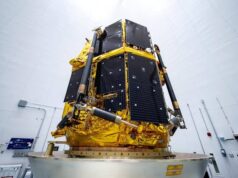Water detected in atmosphere of alien super-Earth planet orbiting in habitable zone
A potentially habitable super-world has been discovered outside our solar system.
Astronomers have detected water vapour in the atmosphere of a planet known as K2-18 b, which is twice the size and eight times the mass of Earth.
This is the first time water has been detected in the atmosphere of a smaller-sized planet orbiting in its star’s habitable zone, they report in the journal Nature Astronomy.
Previously, water had only been discovered in the atmospheres of massive super-hot Jupiter-like gas giants.
“Finding water in a potentially habitable world other than Earth is incredibly exciting,” said the study’s lead author Angelos Tsiaras of University College London in a statement.
But it is not Earth 2.0.
“It is significantly heavier and it has a different atmospheric composition,” Dr Tsiaras said.
K2-18b, which was discovered in 2015, lies 110 light years away from us in the constellation of Leo.
It could either be a rocky planet with an extended atmosphere or an icy planet with a high concentration of water in its interior.
The planet orbits a red dwarf star, which is smaller and cooler than our Sun.
Sitting in its solar system’s habitable region, aka the Goldilocks Zone, K2-18b is thought to have a temperature of between -73 and 46 degrees Celsius.
To look at the planet’s atmosphere, Dr Tsiaras and his colleagues analysed data taken by the Hubble Space Telescope as the planet passed in front of its sun.
Different wavelengths of starlight provide clues about the gases present in the upper atmosphere.
Their models indicated that up to 50 per cent of K2-18 b’s atmosphere could be water.
Not only did they detect traces of water, but their calculations suggest hydrogen and helium may also be present.
Other elements such as nitrogen and methane may also be present, the astronomers said, although they were not detected.
First step towards finding truly Earth-like planets
Astronomer Jonti Horner of the University of Southern Queensland said the discovery was the first step towards finding smaller Earth-like planets capable of supporting life.
“The fact we can now make observations that allow us to work out what’s in the atmosphere of a planet twice the Earth’s radius, orbiting a star that is just over a quadrillion kilometres away, is just amazing.”
But, he said, just because a planet is in the habitable zone, doesn’t mean it is habitable.
“The ‘habitable zone’ is basically just the region around a star where the Earth as it is today would be able to maintain liquid on its surface.”
K2-18 b also orbits a very active star that may blast the planet with radiation, making it much more hostile than our Earth, noted the researchers.
Dr Horner said the discovery could help us better understand planets that sit between the size and mass of Earth and Neptune, known as super-Earths or mini-Neptunes.
“We have no analogue for those kinds of planets in our solar system,” he said.
“Are they more like Earth and the other terrestrial planets, or more like Uranus and Neptune, the solar system’s ice giants?
“At what point do you move from rocky planets with thick atmospheres to things like Neptune?”
Next-generation telescopes such as the James Webb Space Telescope, due to launch in 2021, and the European ARIEL mission in 2028 will explore these questions in much more detail.
These telescopes will also, hopefully, detect smaller planets more like our own.
“They’re the ones that could be able to find water in the atmospheres of truly Earth-sized planets,” Dr Horner said.
“This discovery is a great step in the journey, but we’ve not got to the final destination yet.”






